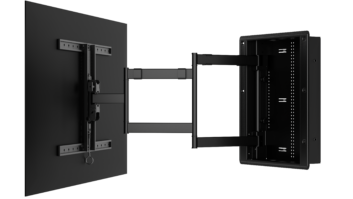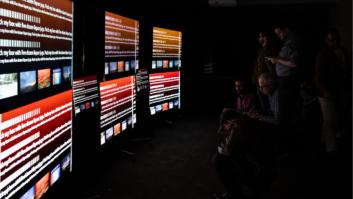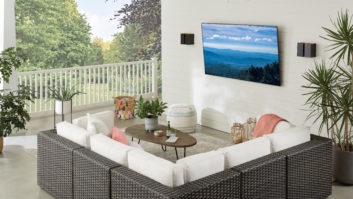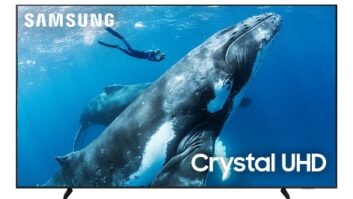Full-motion TV mounts have not changed the world. They have not cured any disease, curbed global warming, or helped married couples stop taking each other for granted. Yet, within the universe of television viewing they have had a major impact.



Perhaps most notable, flatscreen televisions can now be mounted high on a wall, pulled down to eye level (the perfect viewing angle), then returned to their original position. Of course, “high on a wall” generally means “above a fireplace.” For years, prevailing wisdom has deemed this a major no-no, partly for aesthetic reasons, but mostly because it was a bad viewing angle—one that could cause neck strain, backache, even vision issues.
The traditional full-motion mount has partially solved this dilemma and relieved sales associates of having to discourage above-fireplace mounting—a welcome benefit for sales associates and their customers, given that, in many living spaces, the space above the fireplace is the only spot large enough to accommodate a large flatscreen. In fact, the full-motion mount has even helped turn around custom integrators who, for years, have adamantly insisted that a TV should never be put above a fireplace. These mounts have largely dispelled the myths surrounding this antiquated notion.
While all men were created equal, all full-motion mounts were not. There are literally hundreds of them on the market, ranging in cost from as little as $19.99 to over $1,000, and a boatload in between. As a sales associate or electronics dealer, you want to be able to recommend the best full-motion mount for your customer.
To do so, it helps to have a basic knowledge of what’s available, in terms of features, construction, aesthetics, and more. This, however, comes with an important disclaimer: we have to define exactly what “full motion” means in terms of TV wall mounts. Simply put, it means just what it implies: full motion. That translates to movement in four areas: the ability to tilt downward; to swivel left and right; to move vertically (up and down); and to move away from the wall.
Some mounts that label themselves “full motion” do not satisfy all criteria; that is an important caveat for consumers who have decided that they want all three capabilities—and a critical distinction that the sales associate must be able to make clear. Some companies consider their mounts “full motion” with no vertical motion; they can, however, be pulled toward or away from the wall, which is while a useful capability, is no substitute for vertical movement.
As you take in the following comparisons, it’s important to note that some mounts that don’t offer true full motion feature individual capabilities that surpass those incorporated into full-motion mounts. For example, there are mounts that have more swivel than any full-motion mount, or others that can tilt more. Any advantages in a specific area have to be tempered by the fact that they are missing the larger benefits of full motion.
While not intended to be a complete list of differentiators, here are some of the most significant considerations:
TV Size: This is the most obvious parameter to consider. Some mounts will handle flatscreen TVs up to 98 inches; some just 70; some as little as 50. With the cost of larger flatscreens coming down, this is an important factor not to be overlooked. Besides size, also keep in mind that some mounts will fit curved TVs better than others, although the curved-TV fad seems to be coming to the end of its 15 minutes of fame.
Weight Capacity: Despite the ever-increasing size (diagonal measurement) of flatscreens, many are lighter than you might expect. Still, a 55-inch LCD flatscreen can weigh, on average, between 50-75 pounds; a Toshiba 65HT2U 65-inch LCD TV weighs just over 99 pounds. And don’t forget, external speakers and sound bars push that number even higher. While lower-priced full-motion mounts can be easier on the wallet, many have weight capacities as low as 50-70 pounds. Some claim to support weights up to 165 pounds. Thus, it’s critical to match the weight of the customer’s total AV package (TV, speakers, sound bar, etc.) with a mount that will support all that weight. You’ll also want some room to spare. Don’t take it right up to the limit; a fly could land on the TV and pull the whole thing down.
Vertical Movement: This number is pretty much all over the board. In our research, we’ve seen full-motion mounts that will move vertically as little as 11 inches. We’ve seen a few around 16. And we’ve uncovered a couple that top out at 29 inches. Needless to say, the greater the vertical distance, the higher on the wall the TV can be, especially over a fireplace.
Think about it… given the height of most mantels, a TV mounted above that mantel and pulled down just 11 inches will not be at eye level. Ask your customer to estimate how high their mantel is from the floor. From there, you can some quick computations to figure out how much vertical movement they’ll need to get the TV to eye level, or at least pretty close.
Swivel: Our research uncovered full-motion mounts that swivel just 15 degrees left or right. If you are thinking that isn’t very much, you are correct. Others were in the 30- to 35-degree range, allowing for a relatively wide selection of seating choices. We did find one standout that would swivel 35 degrees in either direction or up to 60 degrees one way. Consider the idea that you might be watching a program on the far side of the living room, then decide that you want to do some baking in the kitchen, which is on the other side of the house. Assuming open sight lines, you can theoretically swivel that TV far enough to see it while you’re making your famous chocolate mousse cake.
Tilt: This is a tricky area. The reality is that the tilt function is not used—or needed—in the down position. It’s used in the raised position for those who do not want to always bring their TV down. It’s promoted heavily by makers of non-pulldown mounts who claim that all you need is the tilt function to combat over the fireplace issues. While it can help somewhat, it doesn’t come close to providing the viewing angle that vertical movement does. Tilt helps a little, but it certainly doesn’t help enough. So within the realm of true full-motion mounts, tilt is a non-factor. Still, it’s not a bad idea for your full-motion mount to tilt a few degrees—maybe 3-7 degrees—just in case you want to tweak the viewing angle for your ultra-fussy guest or relative.
Movement from the Wall: The importance of this measurement is often underestimated. There are two main reasons to move the TV out from the wall: To clear the fireplace mantel when you are pulling the TV down to eye level and to satisfy differing viewing preferences in terms of distance from the screen. (There are formulas to identify the ideal distance, but let’s face it, in this area, everyone has a different preference.)
Our research turned up mounts capable of moving out from the 15-16 inches, with a few as little as 13. Again, there are “full motion” mounts that boast distance-from-wall measurements of up to 25 inches, but upon closer inspection, their claim of full motion turn out to be erroneous, so those have to be discounted. If you can safely clear the mantel, you should be fine.
Flush-to-Wall Distance: Some consumers don’t really care how far from the wall the mount sits; others care a great deal and want the “flushest” mount they can find. It’s a simple matter of aesthetic preference. That said, many of the full-motion mounts come in at anywhere between 3-5 inches of distance from the wall. Others we found claim to be as little as 1.25 inches but, in looking more closely, we found that they were not full-motion mounts (i.e., they were not capable of vertical movement). In the world of actual, full-motion mounts, we discovered one that allows for a 1.75-inch mount-to-wall distance, although it required an optional recess box.
Pull Down Handle: This is a somewhat subjective area that is difficult to specifically quantify. If we were physicists, we could get into the area of foot pounds per square inch needed to move the mount up and down, but suffice to say that some are harder than others. Ultimately, it’s based on the construction materials (lightweight but sturdy), as well as the mechanics of the lowering mechanism. Some require a significant amount of “pull” to move them into position; others are much simpler, such that a child could do it. If you have children who are going to use the mount, it’s something to consider. If it’s just adults and you want to make this part of your daily workout, the “hard” pull may be just what you’re looking for.
Cable Management/Wall Covers: This falls under the general area of aesthetics. Obviously, when you’ve got a mount that moves vertically, you’re going to be able to see at least part of the mount on the wall, depending on how far down the mount can move. Wall covers are a sound idea for keeping the look of the wall intact. Cable management is offered on most mounts; some are well designed, others are little more than a twist tie to hold the wires together. Bottom line: make your customers aware that although a minor detail, quality cable management can make a big difference in the overall aesthetic of the installation.
So now you know more about full-motion mounts and the features that can separate the great ones from good ones from the bad ones. Your customer, who is shelling out some big dollars for a new TV, deserves this kind of information. And you deserve the information so that you can create a happy customer – more importantly, a return customer.







